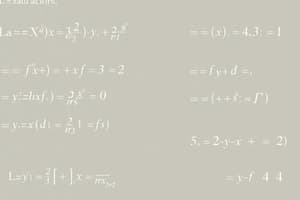Podcast
Questions and Answers
What is the general form of a quadratic equation?
What is the general form of a quadratic equation?
- $$ax^2 + bx + c = 0$$ (correct)
- $$2ax^3 - 3bx^2 + c = 0$$
- $$x^2 + 1 = 0$$
- $$ax + bx^2 = c$$
What does the quadratic formula provide for a quadratic equation?
What does the quadratic formula provide for a quadratic equation?
- Graph coordinates
- Roots or solutions (correct)
- Exponent values
- Coefficient values
What type of function has a quadratic equation as its equation?
What type of function has a quadratic equation as its equation?
- Exponential function
- Quadratic function (correct)
- Trigonometric function
- Linear function
What does the leading coefficient determine about a quadratic function?
What does the leading coefficient determine about a quadratic function?
Flashcards are hidden until you start studying
Study Notes
Quadratic Equation
A quadratic equation is a polynomial function of degree 2, which means it has at least one term with an exponent of 2. The general form of a quadratic equation is:
$$ax^2 + bx + c = 0$$
Where:
- $$a$$, $$b$$, and $$c$$ are real numbers.
- $$a$$ represents the leading coefficient, which is always positive.
- $$b$$ represents the coefficient of the linear term.
- $$c$$ represents the constant term.
Factors and Solutions
A quadratic equation can be written in the form of $$(x-p)(x-q) = (x-p)(x-q)$$, where $$p$$ and $$q$$ are the roots (or solutions). In the standard form, once the equation is written in the form $$ax^2 + bx + c = 0$$, the roots can be found using the quadratic formula:
$$x = \frac{-b \pm \sqrt{b^2 - 4ac}}{2a}$$
This formula gives two possible values for $$x$$, which are the roots of the quadratic equation.
Quadratic Functions
A quadratic function is a function that has a quadratic equation as its equation. It is a polynomial function of degree 2, which means it has a maximum or minimum point, depending on the sign of the leading coefficient. The graph of a quadratic function is a parabola, which is a symmetric shape that opens up if the leading coefficient is positive and down if the leading coefficient is negative.
Example
Consider the quadratic equation:
$$2x^2 + 3x - 4 = 0$$
Using the quadratic formula, the roots of the equation are:
$$x = \frac{-3 \pm \sqrt{(3)^2 - 4(2)(-4)}}{2(2)}$$
$$x = \frac{-3 \pm \sqrt{9 + 16}}{4}$$
$$x = \frac{-3 \pm \sqrt{25}}{4}$$
$$x = \frac{-3 \pm 5}{4}$$
So, the roots of the equation are:
$$x = \frac{-3 + 5}{4}$$
$$x = \frac{2}{4}$$
$$x = \frac{1}{2}$$
And:
$$x = \frac{-3 - 5}{4}$$
$$x = \frac{-8}{4}$$
$$x = -\frac{2}{2}$$
$$x = -1$$
These are the solutions of the quadratic equation.
Studying That Suits You
Use AI to generate personalized quizzes and flashcards to suit your learning preferences.




